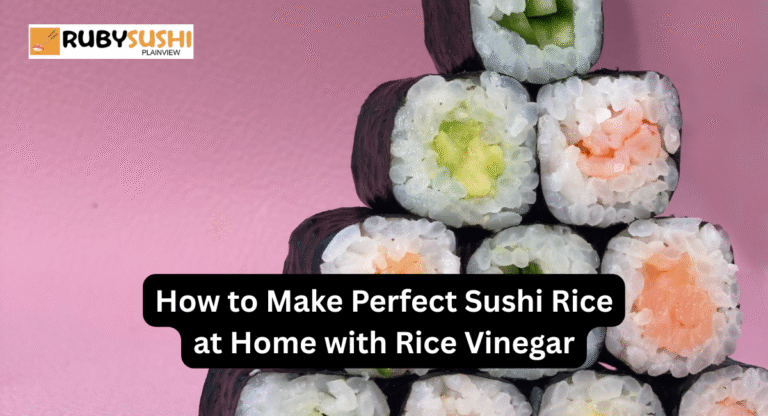Making sushi rice is an art that is the key to making tasty sushi rolls, nigiri, or poke bowls at home. You’ve come to the right place if you want to know how to make perfect sushi rice with rice vinegar for beginners. This guide will show you how to make sticky, shiny, and flavorful rice without any special tools.
Sushi rice tastes different from regular steamed rice because it has a mix of seasoned vinegar that adds a little tang and helps the grains stick together perfectly. With practice, you’ll be able to do this important Japanese technique perfectly, and you’ll be able to make food that tastes like it came from a restaurant.
It’s not just about cooking sushi rice; it’s also about finding the right balance. To get the perfect texture—tender but firm, with a little shine from the vinegar—you need the right amount of rice to water, the right amount of seasoning, and to be gentle with the rice.
This article has everything you need to know about making sushi rice at home, from the ingredients to how to fix problems. It even has tips on the “best methods for seasoning sushi rice with vinegar at home.” Let’s get started and turn plain short-grain rice into something amazing.
Why Rice Vinegar Is Important for Sushi Rice

Before we get into the recipe, let’s talk about what makes sushi rice special. Japanese people often call sushi rice “shari.” It is usually made from short-grain Japanese rice varieties like Koshihikari. These grains have more starch, which makes them sticky, which is what sushi needs.
When you add a vinegar solution called “sushi-su,” which is made of rice vinegar, sugar, and salt, the magic happens. This not only adds flavor to the rice, but it also keeps it fresh for a little while, giving it that real sour-sweet taste.
Rice vinegar is important because it is less acidic than other vinegars and has a subtle acidity that makes the rice taste better without overpowering it. If you use it right, your rice won’t get mushy or too sour. If you’re wondering, “What does rice vinegar do in making perfect sushi rice?” it helps break down the starches a little bit, which gives the rice a shiny finish and keeps it from drying out.
This method came from old ways of preserving food, like fermenting rice with vinegar to go with fish. It’s all about flavor and texture these days, which makes it great for modern foods like California rolls and temaki hand rolls.
A lot of people think that any kind of rice will work, but for the best results, stick to short-grain rice that is labeled “sushi rice.” Sushi will fall apart if you use long-grain rice. If you want to make a “authentic Japanese sushi rice recipe with rice vinegar,” keep in mind that the quality of the ingredients is very important.
Sushi Rice Ingredients
To make about 4 cups of cooked sushi rice (enough for 4 to 6 rolls), you’ll need these things. This recipe is easy to make in bigger batches.
- 1 1/2 cups of short-grain Japanese rice that hasn’t been cooked yet (about 300g)
- 1 3/4 cups of cold water (for cooking)
- 1 small piece of kombu (dried kelp, optional for umami depth)
- 1 tablespoon of sake (optional, for more smell)
- To make the seasoning mix:
- 1/4 cup of plain rice vinegar
- 2 tablespoons of sugar in granules
- 1 teaspoon of fine sea salt
The vinegar gives it a tangy taste, the sugar gives it a sweet taste, and the salt gives it a savory taste. If you choose pre-seasoned rice vinegar, don’t add sugar or salt because that would make it too salty. For “easy homemade sushi rice seasoning with rice vinegar tips,” always taste and change things as you go.
How to Make Perfect Sushi Rice with Rice Vinegar in Steps
For results that are guaranteed, follow this step-by-step guide. The whole thing takes about an hour, including the time it takes to cook and cool.
Step 1: Wash the rice Completely
Put the rice in a bowl or fine-mesh strainer to begin. Gently rub the grains with your fingers while rinsing them under cold running water. Keep going until the water is completely clear. This gets rid of extra starch that could make the rice sticky. You should rinse 5 to 6 times. If you don’t do this, the rice will be cloudy and sticky, making it hard to work with. When you rinse rice for perfect sushi texture with vinegar, make sure the water is clear so that the rice cooks evenly.
Step 2: Soak the rice (not required, but a good idea)
Put the rinsed rice in a pot or rice cooker. If you’re using kombu and sake, add them along with the cold water. Soak it for 20 to 30 minutes. This step gives the grains water, which helps them cook evenly and become fluffy. You can skip it if you’re short on time, but “professional tips for soaking rice before making sushi with vinegar” will change the texture of the rice.
Step 3: Make the Rice
If you’re using a stovetop: Bring the mixture to a boil over high heat. Then, turn the heat down to low, cover it, and let it simmer for 15 to 20 minutes, or until the water is gone. Take it off the heat and let it steam for 10 minutes with the lid on.
For a rice cooker, just choose the white rice setting and let it do its thing.
You can use the Instant Pot to cook on high pressure for 5 minutes and then let it naturally release for 10 minutes. Whichever way you choose, don’t lift the lid while the food is cooking to keep the steam inside. This makes sure that the grains are soft and ready to be seasoned.
Step 4: Get the rice vinegar seasoning ready
Put the rice vinegar, sugar, and salt in a small saucepan while the rice cooks. Do not let the sugar boil; just heat it over medium heat until it dissolves. Or, you can microwave it for 20 to 30 seconds and then stir. Let it cool down a little. This mixture is the key to “how to season sushi rice perfectly with rice vinegar at home,” giving it that shiny, tasty coating.
Step 5: Add spices and let the rice cool
Put the hot cooked rice in a wide, shallow bowl (wooden if you can, to soak up the moisture). Take out the kombu if you used it. Pour the vinegar mixture evenly over the rice. Carefully fold and cut the rice at a 45-degree angle with a wooden paddle or spatula.
Don’t stir it too hard, as this will break up the grains. While folding the rice, use a handheld fan or paper plate to fan it to cool it down quickly and get rid of extra moisture. At first, the rice will look wet, but as it cools to room temperature, it will dry out and become shiny and sticky. Keep it moist until you need it by covering it with a damp cloth.
This cooling method is very important for “getting glossy sushi rice with rice vinegar seasoning” and keeping the rice from getting soggy when you make sushi.
Read More: Try This Classic Southern Banana Pudding Recipe
How to Always Get It Right
Here are some expert tips to help you improve your sushi rice:
- For even absorption, use ingredients that are at room temperature.
- While mixing, fan the rice hard to make it shiny and not mushy.
- If you don’t use it right away, keep it covered at room temperature for up to six hours. Don’t put it in the fridge because it will harden.
- For a change, you can add a little mirin for sweetness or try using brown short-grain rice instead. It won’t be as sticky, though.
- Add a little more vinegar mixture if your rice is too dry. If it’s too wet, fan it for longer.
One mistake to avoid is overcooking the rice, which makes it mushy. Another is using the wrong type of rice. To “troubleshoot common problems with making sushi rice with vinegar,” always measure carefully and be gentle.
Different ways to serve and variations
Once you know how to make sushi rice, you can be creative with it. You can eat it in classic maki rolls with fresh fish and vegetables or in chirashi bowls with lots of toppings. If you want a vegan option, serve it with avocado and cucumber. If you’re looking for “creative ways to use perfect sushi rice seasoned with rice vinegar,” try adding it to salads or onigiri rice balls. Keep in mind that the vinegar not only adds flavor, but it also acts as a natural preservative, which keeps your creations fresh for longer.
FAQs:
Answers to Your Questions About Sushi Rice People often ask, “How do I make perfect sushi rice with rice vinegar step by step?”
How much water should you use for sushi rice?
A 1:1.2 ratio (for example, 1.5 cups of rice to 1.75 cups of water) works well for cooking on the stove, making sure the rice is fluffy.
Can I cook sushi rice without a rice cooker?
Of course! For similar results, use a pot on the stove with a tight lid.
How long can you keep seasoned sushi rice?
In the fridge, it will last for up to three days in an airtight container. To get the texture back, let it come to room temperature before using it.
What makes my sushi rice too sticky or mushy?
This can happen if you rinse or stir too much while seasoning. To avoid this, slice gently and cool the food properly.
Can you use rice vinegar instead of other vinegars?
No, because other ones are too harsh. Use rice vinegar to get the mild flavor that real sushi rice needs.
How can I use long-tail keywords like “easy recipe for perfect sushi rice with rice vinegar” in my cooking?
You don’t have to think too much about it; just focus on the steps: rinse, cook, and season.



